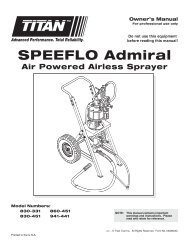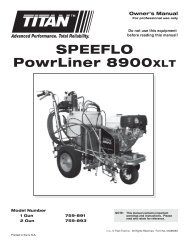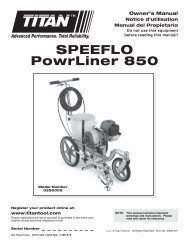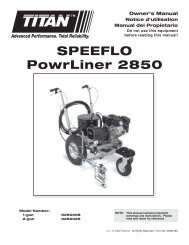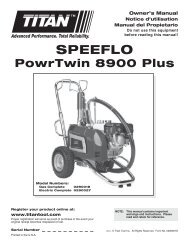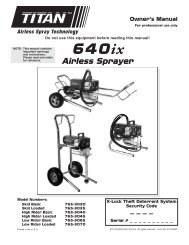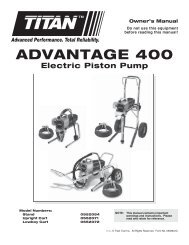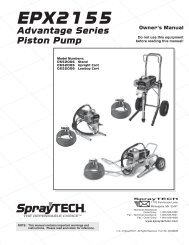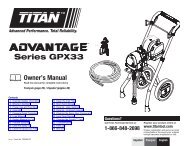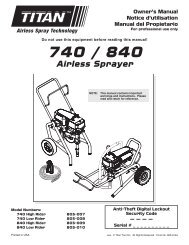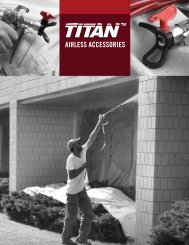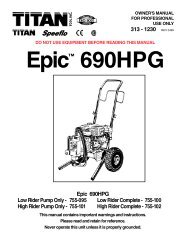You also want an ePaper? Increase the reach of your titles
YUMPU automatically turns print PDFs into web optimized ePapers that Google loves.
Preparing to Paint<br />
Before painting, it is important to make sure that the fluid in the<br />
system is compatible with the paint that is going to be used.<br />
NOTE: Incompatible fluids and paint may cause the<br />
valves to become stuck closed, which would<br />
require disassembly and cleaning of the<br />
sprayer’s fluid section.<br />
Important: Always keep the trigger lock on the spray gun<br />
in the locked position while preparing the system.<br />
1. Place the siphon tube into a container of the appropriate<br />
solvent. Examples of the appropriate solvent are water for<br />
latex paint or mineral spirits for oil-based paints.<br />
2. Place the return hose into a metal<br />
waste container.<br />
3. Set the pressure to minimum by<br />
turning the pressure control knob to<br />
the “MIN” setting.<br />
4. Move the PRIME/SPRAY valve down to the PRIME<br />
position.<br />
NOTE: hold the return hose in the waste<br />
container when moving the<br />
PRIME/SPRAY valve to PRIME in<br />
case the sprayer is pressurized.<br />
5. Turn on the sprayer by moving the ON/OFF switch to the<br />
ON position.<br />
6. Allow the sprayer to run for 15–30 seconds to flush the<br />
old solvent out through the return hose and into the metal<br />
waste container.<br />
7. Turn off the sprayer by moving the ON/OFF switch to the<br />
OFF position.<br />
NOTE: Make sure that the spray gun does not have a tip<br />
or tip guard installed.<br />
8. Move the PRIME/SPRAY valve up to the<br />
SPRAY position.<br />
9. Turn on the sprayer.<br />
10. Unlock the gun by turning the gun trigger<br />
lock to the unlocked position.<br />
Ground the gun by holding it<br />
against the edge of the metal<br />
container while flushing. Failure to<br />
do so may lead to a static electric<br />
discharge, which may cause a fire.<br />
11. Trigger the gun into the metal waste container until the old<br />
solvent is gone and fresh solvent is coming out of the gun.<br />
12. Lock the gun by turning the gun trigger<br />
lock to the locked position.<br />
13. Set down the gun and increase the<br />
pressure by turning the pressure<br />
control knob slowly clockwise.<br />
14. Check the entire system for leaks. If Trigger lock in<br />
leaks occur, follow the “Pressure Relief locked position.<br />
Procedure” in this manual before<br />
tightening any fittings or hoses.<br />
15. Follow the “Pressure Relief Procedure” in this manual<br />
before changing from solvent to paint.<br />
Be sure to follow the pressure relief procedure<br />
when shutting down the sprayer for any purpose,<br />
including servicing or adjusting any part of the<br />
spray system, changing or cleaning spray tips, or<br />
preparing for cleanup.<br />
© Titan Tool Inc. All rights reserved. 5<br />
Painting<br />
1. Place the siphon tube into a container of paint.<br />
2. Place the return hose into a metal<br />
waste container.<br />
3. Set the pressure to minimum by<br />
turning the pressure control knob to<br />
the “MIN” setting.<br />
4. Move the PRIME/SPRAY valve down to<br />
the PRIME position.<br />
5. Turn on the sprayer by moving the ON/OFF<br />
switch to the ON position.<br />
6. Allow the sprayer to run until paint is<br />
coming through the return hose into the metal waste<br />
container.<br />
7. Turn off the sprayer by moving the ON/OFF switch to the<br />
OFF position.<br />
8. Remove the return hose from the waste container and<br />
place it in its operating position above the container of<br />
paint.<br />
9. Move the PRIME/SPRAY valve up to the<br />
SPRAY position.<br />
10. Turn on the sprayer.<br />
11. Unlock the gun by turning the gun trigger<br />
lock to the unlocked position.<br />
Ground the gun by holding it<br />
against the edge of the metal<br />
container while flushing. Failure to<br />
do so may lead to a static electric<br />
discharge, which may cause a fire.<br />
12. Trigger the gun into the metal waste container until all air<br />
and solvent is flushed from the spray hose and paint is<br />
flowing freely from the gun.<br />
13. Lock the gun by turning the gun trigger<br />
lock to the locked position.<br />
14. Turn off the sprayer.<br />
15. Attach tip guard and tip to the gun<br />
as instructed by the tip guard or tip<br />
manuals.<br />
English<br />
Trigger lock in<br />
locked position.<br />
POSSIBLE INJECTION HAZARD.<br />
Do not spray without the tip guard in place. Never<br />
trigger the gun unless the tip is in either the spray or<br />
the unclog position. Always engage the gun trigger<br />
lock before removing, replacing or cleaning tip.<br />
16. Turn on the sprayer.<br />
17. Increase the pressure by turning the pressure control<br />
knob slowly clockwise and test the spray pattern on a<br />
piece of cardboard. Adjust the pressure control knob until<br />
the spray from the gun is completely atomized. Try to<br />
keep the pressure control knob at the lowest setting that<br />
maintains good atomization.<br />
NOTE: Turning the pressure up higher than needed to<br />
atomize the paint will cause premature tip wear<br />
and additional overspray.



